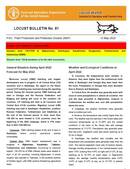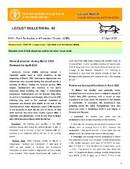General Situation during May 2022 Forecast for June 2022
Moroccan Locust (DMA) fledging, mating and egg
laying started in southern parts of Central Asia. DMA hopper development continued in Azerbaijan, Georgia, Kazakhstan, Kyrgyzstan and Russian Federation. Italian Locust (CIT) hatching and hopper development continued in Georgia and in Central Asian (CA) countries. Migratory Locust (LMI) hatching started in Kazakhstan,...
General Situation during April 2022, Forecast for May 2022
Moroccan Locust (DMA) hatching and hopper development was in progress in all Central Asian (CA) countries and in Azerbaijan. No report on the Italian Locust (CIT) hatching was received during the reporting...
General situation during March 2022 Forecast for April 2022
Moroccan Locust (DMA) hatching started in Tajikistan earlier than in other countries, at the beginning of March. DMA hatching in Afghanistan and Uzbekistan was recorded during the second and third decades of March. During the forecast period, DMA hopper development will continue in the above countries, while hatching will begin...
General situation from November 2021 to February 2022 Forecast until late March 2022
Natural cycles of the three locust species – Italian Locust (CIT), Migratory Locust (LMI) and Moroccan Locust (DMA) ended in late summer/early autumn in all countries with eggs laid in the soil, where they overwinter (embryonic diapause). During the forecast period, DMA hatching may occur in northern Afghanistan and southern...
General Situation during August 2021 Forecast for September 2021
Italian (CIT) and Asian Migratory (LMI) Locusts finished mating and egg-laying in most countries and started to die-off. The situation in August became calm for all species in most countries. A cautious situation with CIT still remains in Georgia. During the forecast period, CIT and LMI natural life cycles will...






